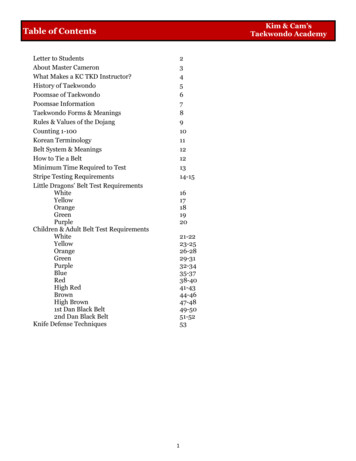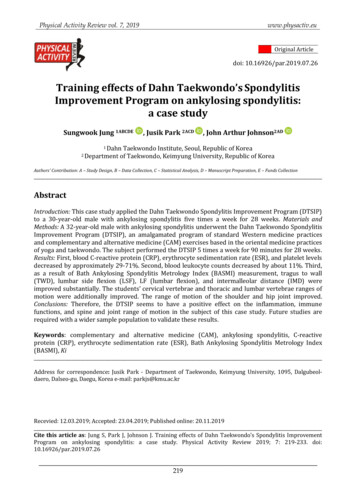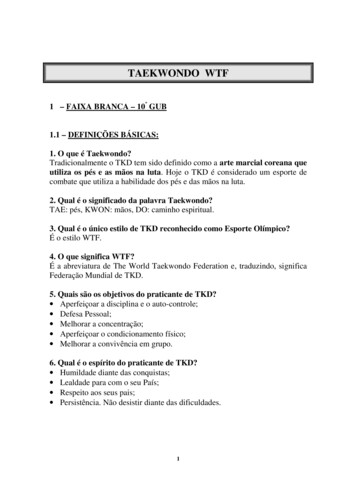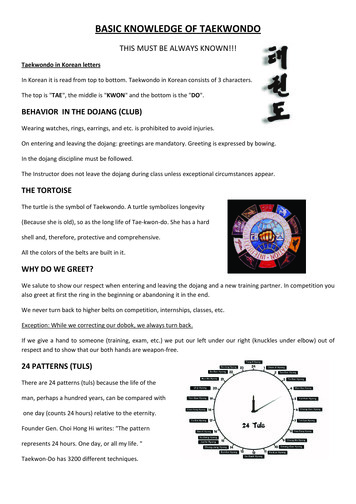
Transcription
Kim & Cam’sTaekwondo AcademyTable of ContentsLetter to StudentsAbout Master CameronWhat Makes a KC TKD Instructor?History of TaekwondoPoomsae of TaekwondoPoomsae InformationTaekwondo Forms & MeaningsRules & Values of the DojangCounting 1-100Korean TerminologyBelt System & MeaningsHow to Tie a BeltMinimum Time Required to TestStripe Testing RequirementsLittle Dragons’ Belt Test RequirementsWhiteYellowOrangeGreenPurpleChildren & Adult Belt Test h RedBrownHigh Brown1st Dan Black Belt2nd Dan Black BeltKnife Defense -5253ϭ
Kim & Cam’sTaekwondo AcademyLetter to StudentsDear Taekwondo Family,This manual is dedicated to all of the instructors and students. Over the years that our school has beenopen, many of you have requested written information ranging from the correct Korean names for different stances, blocks, and punches to the origins of Taekwondo itself. I have designed this manual tohelp answer your questions. It should be used as a reference guide and should help in both learningand teaching Taekwondo.Taekwondo is the most popular martial art in the world. It was a demonstration sport at the 1988Summer Olympics in Seoul, Korea as well as the 1992 Summer Olympics in Barcelona, Spain. Beginning with the 2000 Summer Olympics in Sydney, Australia it is a full medal sport, one of only twomartial arts to have this honorable distinction.Taekwondo has rapidly grown in popularity through the years due to the immense benefits it provides.Many of my students have found greater self-confidence, physical and mental discipline, and improvedhealth as a result of their training. I hope you will all benefit from Taekwondo as I have through theyears.Sincerely,Master Cameron B. WeberϮ
Kim & Cam’sTaekwondo AcademyAbout Master Cameron WeberMaster Cameron Weber is a 4th Degree Black Belt certifiedby Kukkiwon (World Taekwondo Headquarters) and has dedicatedhis life to Martial Arts and improving lives of children, teens, andadults. Master Cam's true passion is working with children andhaving a positive impact on their lives and future aspirations. Heleads high energy, fun, and unique classes to suit a variety of agesand learning styles. He is one of the few Masters in the world proficient in traditional, International Taekwondo Federation (ITF)style and World Taekwondo Federation (WTF) Olympic styleTaekwondo. Master Cam is the Head instructor of Kim & Cam'sTaekwondo Academy. He personally teaches and interacts witheach student, building lasting, meaningful relationships.Taekwondo Accomplishments:4th Dan, Master Instructor- Kukkiwon Certified (World Taekwondo Headquarters)2013 USA National Collegiate Taekwondo Team Member (Represented USA in South Korea)1st Place 2013 USAT National Collegiate Championships2nd Place 2013 USAT Senior National Championships2nd Place 2014 USAT National Collegiate ChampionshipsColorado State Taekwondo Team Member- 5 time State ChampionCertified USA Taekwondo RefereeCertified USA Taekwondo CoachRocky Mountain Collegiate Taekwondo League- League MVPUndefeated in Colorado sanctioned sparring eventsTraining Experience in South Korea, the birth place of TaekwondoDefeated Korean Collegiate National Team Member in televised scrimmage in South KoreaLicensed Global AthleteFeatured in Moosin Martial Arts MagazineEducation and Credentials:Business Management Degree (Honors), Media Studies (Minor)- Colorado State UniversitySpring 2014Background Check with Douglas County School District 2014Safe Sport Background Check with USA Taekwondo 2014CPR and AED Certifiedϯ
Kim & Cam’sTaekwondo AcademyAbout KC Taekwondo InstructorsOur instructors are what makes Kim & Cam’s Taekwondo Academy unique. We believe that qualityinstructors make the difference when it comes to your Taekwondo education. All instructors at Kim &Cam’s Taekwondo Academy are specially trained and brought up through our Taekwondo program sothey have an extensive quality education to incorporate into their teaching. In addition to a substantialTaekwondo background, all of our instructors participate in our Leadership Elite program which instills good teaching habits and leadership development. These skills are crucial to us as there is moreto being a good instructor than athleticism.ϰ
Kim & Cam’sTaekwondo AcademyHistory of TaekwondoTaekwondo is a Korean martial art that began over 2000 years ago. Archaeologists havefound drawings on the walls of ancient tombs thatshow men practicing different blocks and punches. The existence of these murals allows historiansto date the origins of what we now call Taekwondoto around 50 BC.In ancient times, Korea was divided into threekingdoms: Koguryo, Paekje, and Silla. Sillalater unified the three kingdoms after winning the war against Paekje in 668 AD and Koguryo in 670 AD. The Hwa Rang Do helped in thisunification. The Hwa Rang Do was an elite groupof young noble men who devoted themselves toimproving both their minds and bodies to betterserve their kingdom of Silla. The Hwa RangDo had an honor code and practiced variousforms of martial arts, including Tae Kyon and SooBakh Do. These forms of martial arts are the origins of what we call Taekwondo today. Additionally, the honor code practiced by the Hwa Rang Dois the philosophical basis of modern Taekwondo.Many years of peace followed the unification ofthe three kingdoms and allowed the people of Korea to learn and practice these marital arts.Unfortunately, in 1909 the Japanese invaded Korea and forbid the practice of their marital art,that was then being called Soo Bak. Fortunately,people continued to practice Soo Bak in secret.At the end of WWII, when Japan was driven fromKorea, several different styles of martial arts began to develop. A style or school of martialarts was called a “Kwan”. Some of the different Kwans that developed were “Chung Do Kwan”,“Moo Duk Kwan”, “Yun Moo Kwan”, and “Ji DoKwan”. Although they were similar in many ways,there were small differences. There was no unified way to bow, punch, kick, or compete.Eventually, the leaders of the separate kwansagreed that the different styles needed to unite inorder to grow.In 1955, the kwans unified and in 1957, thename Taekwondo was adopted. In 1973, theWorld Taekwondo Federation (WTF) was foundedand in 1980, the International Olympic Committee (IOC) recognized the WTF. The 1988 & 1992Summer Olympics presented Taekwondo as ademonstration sport and beginning with the2000 Summer Olympics in Sydney, Australia,Taekwondo has joined Judo as the only twomartial arts to be recognized by the IOC.ϱ
Kim & Cam’sTaekwondo AcademyPoomsae (Forms) of Taekwondo"Poomsae" is the Korean word for a form. All students of Taekwondo are required to learn certain forms. As students of the WTF style of Taekwondo you will learn Taegeuk Poomsae. The Taegeukforms of Taekwondo are paradigms of the martial art. They contain the basic physical movements andalso the philosophical thoughts from which the art was derived.Literally, “Tae” means bigness and “geuk” means eternity. Combined Taegeuk means “greateternity”. The 8 patterns of the Taegeuk forms derive their meanings from the basic tenets of theorient’s oldest philosophical work, The Book of Changes. Koreans call this book Jooyeok. In theBook of Changes the universe is divided into eight subsequent combinations derived from the majorforces of the universe, Yin and Yang. Yin is the ultimate creative power and Yang is the ultimate receptive power.Each combination is represented by a symbol called a trigram, because it contains three lines. As thefigure on the following page demonstrates, the 8 trigrams are arranged in a circle around the symbolfor Yin and Yang. Opposite pairs are positioned across the circle from one another, to represent theinterdependent polarities that compose the universe.The following chart denotes the eight forms of Taekwondo and their meanings:1. Taegeuk Il Jang2. Taegeuk Yi Jang3. Taegeuk Sam Jang4. Taegeuk Sa Jang5. Taegeuk Oh Jang6. Taegeuk Yuk Jang7. Taegeuk Chil Jang8. Taegeuk Pal JangKeonTaeRiJinSeonGamGanGonHeaven & LightJoyFire & ClarityThunderWindWaterMountainEarthTogether these concepts and symbols represent the balance of all nature. In the training ofTaekwondo, as in life, we hope to find this balance. The poomsae carry with them not only the physicalmovements but also the meaning of Taekwondo.ϲ
Kim & Cam’sTaekwondo AcademyPoomsae InformationThe following should be considered while performing forms:1. Form should begin and end at exactly the same spot. This indicates the quality of theperformer’s stances and technique.2. Correct posture and body position must be maintained at all times.3. Muscles of the body should be either tensed or relaxed at the proper, critical momentsin the form.4. The exercise should be performed in a rhythmic movement with an absence of stiffness.5. Movement should be accelerated or decelerated according to the specifications of thatpattern.6. Exhale on exertion of each technique in order to maximize power.7. Each pattern should be perfected before moving to the next.8. Students should know the purpose of each movement.ϳ
Kim & Cam’sTaekwondo AcademyTaekwondo Forms and MeaningsWTF STYLE (OLYMPIC STYLE)1.TAEGEUK IL JANG2. TAEGEUK YI JANGJoy3. TAEGEUK SAM JANGFire and clarity4. TAEGEUK SA JANGThunder5. TAEGEUK OH JANGWind6. TAEGEUK YUK JANGWater7.MountainsTAEGEUK CHIL JANG8. TAEGEUK PAL JANG10. KEUMGANG Means “diamond”, symbolizing hardness. Keumgang is also the name of the most beautifulmountain in Korea, as well as the Keumgang Warrier,named by Buddha. Thus, the themes of hardness,beauty, and pondering permeate this Poomsae.Heaven and light11. TAEBEK Translates to “lightness”. Every movementin this Poomae is intended to be not only exact andfast, but with determination and hardness, resemblingthe mountain Baekdoo, the origin of the nation of Korea.Earth12. PYONGWON Translates roughly to “vast plain”.The plain is a source of sustaining the human lifeand , on the other hand, a great open plain stretchingout endlessly gives us a feeling of majesty that is different from what we feel with a mountain or the sea.9. KORYO Named after an old Korean Dynasty. Thepeople from the Goryeo defeated the Mongolian aggressors. It is intended that their spirit is reflectead inthe movements of the Poomsae Koryo. Each movement of this Poomsae represents the strength andenergy needed to control the Mongols.INTERNATIONAL TAEKWONDO FEDERATION (ITF) STYLE1.CHONJI Means literally "the Heaven the Earth". It is, 8.in the Orient, interpreted as the creation of the world orthe beginning of human history, therefore, it is the initialpattern played by the beginner. This pattern consists oftwo similar parts; one to represent the Heaven and the9.other the Earth.HWARANG Named after the Hwa-Rang youth group,which originated in the Silla Dynasty in the early 7thcentury. The 29 movements refer to the 29th InfantryDivision, where Taekwondo developed into maturity.CHOONGMOO Named after the great Admiral YiSoon-Sin of the Lee Dynasty. He was reputed to haveinvented the first armored battleship (Kobukson) in1592, which is said to be the precursor of the present daysubmarine. The reason why this pattern ends with a lefthand attack is to symbolize his regrettable death, havingno chance to show his unrestrained potentially checkedby the forced reservation of his loyalty to the king.2.DANGUN Named after the holy Dan-Gun, the legendary founder of Korea in the year of 2,333 B.C.3.DOSAN Pseudonym of the patriot, Ahn Chang-Ho(1876-1938). The 24 movements represents his entire lifewhich he devoted to furthering the education of Koreaand its independence movement.4.WONHYO Noted monk who introduced Buddhism tothe Silla Dynasty in the year of 686 A. D.5.YULGOK Pseudonym of a great philosopher andscholar, Yi l (1536-1584) nicknamed the “Confucius ofKorea”. The 38 movements of this pattern refer to hisbirthplace on 38 latitude, and the diagram represents“scholar”.6.JOONGGUN Named after the patriot Ahn Joong-Gunwho assassinated Hiro-Bumi Ito, the first Japanese governor-general of Korea, known as the man who playedthe leading part in the Korea-Japan merger. There are 32movements in this pattern to represent Mr. Ahn’s agewhen he was executed in a Lui-Shung prison (1910).7.TOIGYE Pen name of the noted scholar Yi Hwang12. GE BAEK Named after Ge Baek, a great general in the(16th century), an authority on neo Confucianism. The 37Baek Je Dynasty (660 A.D.). The diagram represents hismovements of the pattern refer to his birthplace on 37severe and strict military discipline.latitude, and the diagram represents “scholar”.10. KWANGGAE Named after the famous Kwang-GaeToh-Wang, the 19th King of the Koguryo Dynasty, whoregained all the lost territories including the greater partof Manchuria. The diagram represents the expansion andrecovery of lost territory. The 39 movements refer to thefirst two figures of 391 A.D., the year he came to thethrone.11. POEUN Pseudonym of a loyal subject Chong MongChu (1400) who was a famous poet and whose poem “Iwould not serve a second master though I might be crucified a hundred times” is known to every Korean. He wasalso a pioneer in the field of physics. The diagram represents his unerring loyalty to the king and country towards the end of the Koryo Dynasty.ϴ
Kim & Cam’sTaekwondo AcademyRules and Values of the Dojang1.2.3.4.5.6.7.8.9.10.11.12.Arrive early to classAlways bring your attendance card into class.Attend at least two classes per week.Students must bow when they enter or exit the school’s lobby.Students must bow to the flags when entering or leaving the Dojang (training area).Students must bow to the Masters and Instructors the first time they see them and the first timethey enter the Dojang.Tie your belt correctly and present yourself in a clean, neat manner.Bring your full set of Kim & Cam’s Taekwondo Academy approved sparring equipment for all sparring classes.Never climb on the kicking bags or misuse any equipment.Never use bad language or insult another student.Help keep the Dojang neat and orderly.Do not engage in rough play before or after class.Tenets of Taekwondo1. Courtesy2. Integrity3. Perseverance4. Indomitable Spirit5. Self-ControlTaekwondo Oath1. Observe the Tenets of Taekwondo2. Respect my instructor and senior belts3. Never misuse Taekwondo4. Build a more peaceful world5. Be a champion of freedom and justiceEtiquette When lining up, students should line up by rank and then by age allowing higher ranking studentsand more senior students to line up first. When in groups, the lowest ranking student should get any required equipment. If there are multiple students of the same rank, the younger student should get the equipment. Bow and use two hands when exchanging equipment, papers, certificates, or any other items. Answer up. All questions and commands should be answered “Yes Sir/Ma’am” or “No Sir/Ma’am”.CommandsCharyotKukke Yea DeehayoKwanjangnimSabumnim KyeKyosanim KyeKyunyeahKamsa HabneedaHechoAttentionTo the FlagTo the Head MasterTo the Master (4th to 6th degree)To the Instructor (2nd to 3rd degree)BowThank You Very MuchDismissedHow to Address Senior Belts“Kwanjangnim”Head Master“Sabumnim”Master (4th degree Black Belt or higher)“Kyosanim”Instructor (2nd and 3rd degree Black Belt)When you are at the school, you must always address all senior belts as “Sir” or “Ma’am”.All questions are to be answered “Yes Sir/Ma’am” or “No Sir/Ma’am”ϵ
Kim & Cam’sTaekwondo AcademyKorean NumbersEnglishKorean1 OneHana2 TwoDule3 ThreeSet4 FourNet5 FiveDasot6 SixYosot7 SevenIl Gob8 EightYo Dul9 NineAhop10 TenYul20 TwentySumul30 ThirtySarun40 FortyMahun50 FiftyShehun60 SixtyYesun70 SeventyIlhun80 EightyYodun90 NinetyAhun100 One hundredBakKorean Ordinal al9thGoo10thShipϭϬ
Kim & Cam’sTaekwondo AcademyKorean TerminologyBar Chagie (Basic Kicks)Gyorugy JazaeFighting StancePodo OliguiRising KickAp ChaggieFront KickPique ChaggieRoundhouse KickYop ChaggieSide KickBacat ChaggieOutside Crescent KickAn ChaggieInside Crescent KickTchigo ChaggieAxe KickDolio ChaggieHigh Roundhouse KickMido ChaggiePush KickTi ChaggieBack KickTi Dolio ChaggieSpinning Hook KickTimio Ti ChaggieJumping Back KickTimio Ti Dolio ChaggieJumping Spinning Hook KickNaraban ChaggieButterfly KickKibon Don Jak (Basic stances and hand techniques)NaraniShoulder StanceWaysantul MakkiMountain BlockApkubiFront StanceTuc ChiggieChin Strike/Upper CutArae MakkiLow BlockAbsogiWalking StanceMonton ThiruguiMiddle PunchJebipoom Hansonal Moc ChiggieKnife Hand Neck StrikeOrgule MakkiFace BlockTui KubiBack StancePyonsoncut Seuo ThirugieMiddle Target Spear Finger StrikeSonal Godolo MakkiDouble Knife Hand Middle BlockJebipoom Moc ChiggiePalm Rising Block with Neck StrikeHansonal Monton MakkiSingle Knife Hand Middle BlockDung Jumoc Ap ChiggieFront Back Fist StrikeBacant Palmoc MakkiOuter Arm Middle BlockPalgub Dolio ChiggieElbow StrikeAn Palmoc MakkiInner Arm Middle BlockPalgub ChiggieElbow Strike to PalmSonal Arae MakkiDouble Knife Hand Low BlockHansonal Bitro MakkiSingle Knife Hand Twist BlockGodolo Bacat MakkiDouble Arm Outer BlockOrgule Bacat MakkiHigh Outer BlockGodolo Bacat Arae MakkiDouble Arm Outer Low BlockBatanson Monton MakkiPalm Middle BlockBoomsogiTiger StanceKawe MakkiScissor BlockBantanson Monton MakkiPalm Middle BlockHecho MakkiSpread BlockMonton MakkiMiddle BlockUtgoro MakkiLow “X” BlockDung Jucmoc Ap ChiggieFront Back Fist Strikeϭϭ
Kim & Cam’sTaekwondo AcademyBelt System and Meanings10th GupWhite BeltPurity — No knowledge of Taekwondo9th GupYellow BeltSunrise — Opening to receive new knowledge8th GupOrange BeltSunset — Promise of a better tomorrow7th GupGreen BeltPlant — Growth6th GupPurple BeltPower — The royal color of majesty5th GupBlue BeltSky — Unlimited boundaries4th GupRed BeltFire — Caution3rd GupHigh Red BeltVolcano — Fire creating Earth2nd GupBrown BeltEarth — Solid like mountains1st GupHigh Brown BeltMaturity — Ready to face responsibility1st DanBlack BeltCompletion of a life cycle and beginning of new lifeHow to Tie a BeltϭϮ
Kim & Cam’sTaekwondo AcademyMinimum Time Required to TestThe table below shows the minimum amount of time and number of classes required to be eligibleto test. This applies to all students unless they are enrolled in a private lesson program or receivepermission from Master Cam.Current Belt ColorTimeClassesWhiteNot SpecifiedNot SpecifiedYellow2 months20 classesOrange2 months20 classesGreen3 months30 classesPurple3 months30 classesBlue4 months40 classesRed4 months40 classesHigh Red5 months50 classesBrown6 months50 classesHigh Brown6 monthsNot Specifiedϭϯ
Kim & Cam’sTaekwondo AcademyStripe Test RequirementsStudents in the TKD Tigers’ and KC Kids’programs will earn stripes towards their nextbelt. Stripes prove to be a good way to help ouryounger students set intermediate goals andunderstand that one cannot always jumpimmediately to “the big prize.” Many times it isimportant to set smaller goals along the way toachieving a larger goal. The stripe system alsohelps students understand what they need toknow and what a reasonable amount of time isto learn and develop an intimate understandingof their curriculum. Students of all belt colorsfrom white to brown will need to earn fourstripes of their next color belt in order to test fortheir next rank.In addition to the four colored stripes, studentswill need to earn white stripes. White stripes areearned based on merit. Students can earn whitestripes for a variety of behaviors including, butnot limited to, working hard, exceptionaldiscipline and respect, or setting a positiveexample outside of the Dojang. White belts arenot required to earn white stripes. Yellow,orange, green, and purple belts need to earn atleast one white stripe. Students who are blue,red, high red, or brown belts need to earn atleast two white stripes to test.First degree black belts under age 13 (in the KCKids’ program) will also earn stripes. Stripes areawarded for each of the new forms that they arerequired to learn.The tables on the next page show what students(TKD Tigers’ and KC Kids’) need to know andapproximately how many classes they need toattend to earn each stripe. Instructors retain theright to promote students more quickly orslowly than described below based on a varietyof factors including behavior, effort, skill level,and private lessons. Please note that thenumber of classes for the last stripe is less thanthe required number of classes to test asstudents should know everything ahead of timeand polish their technique prior to testing.ϭϰ
Kim & Cam’sTaekwondo AcademyStripe Test RequirementsColor Belt Stripe System:BeltColor1st Stripe2nd Stripe3rd Stripe4th 9Form Footwork12Full FormYellow4Kicks & HandTechniques8One-third of form12Two-thirds ofform16Full FormOrange4Kicks & HandTechniques8One-third of form12Full form16FallingGreen7Kicks & HandTechniques14First half of form21Full form28FallingPurple7Kicks & HandTechniques14First half of form21Full form281 Step Sparring &RollingBlue8Kicks & HandTechniques16First half of form24Full form321 Step Sparring &FallingRed8First half of form16Full form241 Step Sparring32Knee Sparring &RollingHigh Red11First half of form22Full form331 Step Sparring44Knee SparringBrown11First half of form22Full form331 Step Sparring &Knee Sparring44Adult whitethrough orangeself-defense1st Dan Black Belt Stripe System:Stripe ColorRequirementTime Since Black Belt TestFormWhite2 monthsKoryoYellow4 monthsTosanOrange6 monthsWon YoGreen8 monthsYul GokPurple10 monthsJoon GunBlue12 monthsTaegeuk 1-5Red14 monthsTaegeuk 6-8, Chonji, Dangunϭϱ
Kim & Cam’sTaekwondo AcademyBelt Test RequirementsTKD Tigers (Age 4-6)WHITE BELT(Testing White to Yellow)Physical RequirementsA) Kicks1. Rising kick2. Front snap kick3. Roundhouse kick4. Side kickB) Hand Techniques1. High block2. Middle inner block3. Low block4. Middle punchC) Stances1. Attention stance2. Ready stance3. Shoulder stance4. Fighting stance5. Horse riding stance6. Front stance7. Listening stanceD) Form1. TKD Tiger Oren Saju Chedegi(4 punches & 4 blocks)Mental RequirementsA) Count from 1 to 5 in Korean1. One – Hana2. Two – Dule3. Three – Set4. Four – Net5. Five – DasotC) Know what part of the foot is used to strike foreach kick1. Rising kick – Back of the heel2. Front snap kick – Ball3. Roundhouse kick – Top4. Side kick – Bottom of the heelB) Tenets of Taekwondo1. Courtesy2. Integrity3. Perseverance4. Indomitable Spirit5. Self-controlD) Phone Number1. Home phone number or parents’ cell phonenumber(s)ϭϲ
Kim & Cam’sTaekwondo AcademyBelt Test RequirementsTKD Tigers (Age 4-6)YELLOW BELT(Testing Yellow to Orange)Physical RequirementsA) Kicks1. Axe kick2. High roundhouse kick3. Inside crescent kick4. Outside crescent kick5. All previous kicksC) Stances1. Walking stance2. All previous stancesD) Form1. TKD Tiger Taegeuk Il JangB) Hand Techniques1. Reverse middle punch2. Reverse middle inner block3. All previous hand techniquesMental RequirementsA) Count from 1 to 10 in Korean1. One – Hana2. Two – Dule3. Three – Set4. Four – Net5. Five – Dasot6. Six — Yosot7. Seven — Il Gob8. Eight — Yo dul9. Nine — Ahop10. Ten — YulB) Meaning of the Tenets of Taekwondo1. Courtesy — Be nice to others2. Integrity — Do not lie3. Perseverance — Never give up4. Indomitable Spirit — Stay mentally strong5. Self-control — Always behaveC) Know what part of the foot is used to strike foreach kick1. Axe kick — Back of the heel2. High roundhouse kick — Top3. Inside crescent kick — Inside edge of foot4. Outside crescent kick — Outside edge of footD) Home Addressϭϳ
Kim & Cam’sTaekwondo AcademyBelt Test RequirementsTKD Tigers (Age 4-6)ORANGE BELT(Testing Orange to Green)Physical RequirementsA) Kicks1. Push kick2. Back kick3. Jumping side kick4. All previous kicksB) Hand Techniques1. High punch2. All previous hand techniquesC) Stances1. All previous stancesD) Form1. TKD Tiger Taegeuk Yi JangE) Board Breaking1. Push kickMental RequirementsA) Why do you Bow?1. To show respect. SIR/MA’AM!B) When do you Bow?1. We bow when we enter and exit the school2. We bow to the flags when we enter and exit the Dojang3. We bow to the Masters, Instructors, and all black belts anytime and anywhere we see themC) Know and show right and leftD) Know what part of the foot is used to strike for each kick1. Push kick — Bottom of the heel2. Back kick — Bottom of the heel3. Jumping side kick — Bottom of the heelE) Count 11-20 in Korean1. Eleven — Yul hana2. Twelve — Yul dule3. Thirteen — Yul set4. Fourteen — Yul net5. Fifteen — Yul dasot6. Sixteen — Yul yoset7. Seventeen — Yul il gob8. Eighteen — Yul yo dul9. Nineteen — Yul ahop10. Twenty — Sumulϭϴ
Kim & Cam’sTaekwondo AcademyBelt Test RequirementsTKD Tigers (Age 4-6)GREEN BELT(Testing Green to Purple)Physical RequirementsA) Kicks1. Spinning hook kick2. Butterfly kick3. Jumping front kick4. All previous kicksB) Hand Techniques1. Knife hand neck strike2. Single middle knife hand block3. All previous hand techniquesC) Stances1. All previous stancesD) Form1. TKD Tiger Taegeuk Sam JangMental RequirementsA) Why do you yell in Taekwondo?1. To show power, focus, and confidence. SIR/MA’AM!B) Taekwondo Oath1. I will observe the Tenets of Taekwondo2. I will respect my instructors and seniors3. I will never misuse Taekwondo4. I will help build a more peaceful world5. I will be a champion of freedom and justiceC) Know what part of the foot is used to strike for each kick1. Spinning hook kick — Back of the heel2. Butterfly kick — Top of the foot3. Jumping front kick — BallD) Count to 40 in Korean1. Thirty — Sarun2. Forty — Mahunϭϵ
Kim & Cam’sTaekwondo AcademyBelt Test RequirementsTKD Tigers (Age 4-6)PURPLE BELT(Testing Purple to Blue)Physical RequirementsA) Kicks1. Double roundhouse kick2. Skipping front leg roundhouse kick3. All previous kicksB) Hand Techniques1. Double middle knife hand block2. Palm block3. Palm rising block4. Spear hand strike5. All previous hand techniquesC) Stances1. Back stance2. All previous stancesD) Form1. TKD Tiger Taegeuk Sa JangMental RequirementsA) Home Rules1. Be respectful to your parents, brothers, sisters, and pets2. Keep your room clean3. Put toys away after playing with them4. Work hard in schoolB) Know how to tie your beltC) What are the rules of the dojang?1. See Introduction section of the manual, page 8.D) Know what part of the foot is used to strike for each kick1. Double roundhouse kick — top of the foot2. Skipping front leg roundhouse kick — top of the footϮϬ
Kim & Cam’sTaekwondo AcademyBelt Test RequirementsWHITE BELT(Testing White to Yellow)Physical RequirementsA) Kicks1. Rising kick2. Front snap kick3. Roundhouse kick4. Side kickB) Hand Techniques1. High block2. Middle inner block3. Low block4. Middle punchC) Stances1. Attention stance2. Ready stance3. Shoulder stance4. Fighting stance5. Horse riding stance6. Front stance7. Listening stance (children only)8. “Kick me” stance (should never be used)D) Form1. Oren Saju Chedegi2. When Saju Chedigi (Adults only)E) Self-Defense (Adults OnlyThe theme for the white belt self-defense is understanding the “Rule of Thumb”. The thumb is theweakest part of a grip and, therefore, the best place to try and escape.1. Straight arm grab (right on left/left on right)— Circle towards the middle of your body and escape through the thumb2. Cross hand grab (right on right/left on left)— Circle towards the outside of the body and escape through the thumbϮϭ
Kim & Cam’sTaekwondo AcademyBelt Test RequirementsWHITE BELT(Testing White to Yellow)Mental RequirementsA) What is Taekwondo?1. Taekwondo is a Korean martial art, which originated about 2000 years ago. “Tae” means techniques of the foot — kicking and jumping. “Kwon” means the techniques of the hand — punches, strikes, and blocks. “Do” means the art and manner of life. “Sir/Ma’am”!B) What is the Bow?1. An oriental form of greeting and a symbol of respect. “Sir/Ma’am”!C) Why do you Bow?1. We bow to show respect. “Sir/Ma’am”!D) When do you Bow?1. When we enter/exit the school2. When we enter/exit the Dojang3. We bow to the Masters4. We bow to the Instructors5. We bow to all other black belts and our fellow studentsE) What is the meaning of the white belt?1. The white belt signifies purity, no knowledge of Taekwondo. “Sir/Ma’am”!F) Count from 1 to 5 in Korean1. One — Hana2. Two — Dule3. Three — Set4. Four — Net5. Five — DasotG) Tenets of Taekwondo and their meanings1. Courtesy — Be nice to others and treat them with respect2. Integrity — Do not lie and treat others fairly3. Perseverance — Never give up4. Indomitable Spirit — Keep a positive attitude5. Self-control — Control your thoughts, words, and actionsH) Know what part of the foot is used to strike for each kick1. Rising kick — Back of the heel2. Front snap kick — Ball3. Roundhouse kick — Instep (top)4. Side kick — Bottom of the heelI) Be able to identify, define, and answer questions about the current life skill concept. (Children only)ϮϮ
Kim & Cam’sTaekwondo AcademyBelt Test RequirementsYELLOW BELT(Testing Yellow to Orange)Physical RequirementsA) Kicks1. Axe kick2. High roundhouse kick3. Inside crescent kick4. Outside crescent kick5. All previous kicksB) Hand Techniques1. Reverse middle punch2. Reverse middle inner block3. Low punch4. All previous hand techniquesC) Stances1. Walking stance2. All previous stancesD) Form1. Taegeuk Il Jang2. All previous forms (Adults only)E) Self-defense (Adults only)The theme for the yellow belt self-defense is how to escape and counter from single hand wristgrabs.1. Straight arm grab (right on left/left on right)i) On the hand that is being grabbed, turn the hand so the palm is facing up. Reach underneathwith the fre
style and World Taekwondo Federation (WTF) Olympic style Taekwondo. Master Cam is the Head instructor of Kim & Cam's Taekwondo Academy. He personally teaches and interacts with each student, building lasting, meaningful relationships. Taekwondo Accomplishments: 4th Dan, Master Instructor- Kukkiwon










